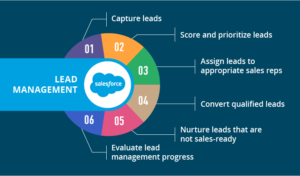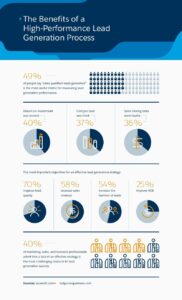7 Salesforce Lead Management Best Practices
Establishing Salesforce lead management best practices within your organization will help your sales team convert potential customers into loyal buyers. Does your organization have set criteria for how to manage leads?
Nearly half of marketers and sales professionals state that the lack of an effective lead generation strategy is the most challenging obstacle for converting leads. Help your teams overcome these challenges.
Before examining the seven best practices highlighted in this article, let’s first review lead management with a brief introduction to what it means.
Introduction into Lead Management
Lead management is made easier with Salesforce Leads. These management tools take contacts and help your sales team qualify them to turn them into opportunities to generate revenue.
The problem is, not every contact is qualified to make decisions, and you don’t want that information clogging up sales funnels. You can set up lead management best practices to ensure that only decision-makers are the people your sales staff speak with.
For example, at a trade show, someone from a company may place their business card in a raffle for a drawing for the free iPad you’re giving out.
However, with this lead-generating tactic, not everyone who places their business card in the raffle is a qualified decision-maker. These people may provide information about who has buying power in the company.
For that reason, they’re still worth placing in the database as a contact, just not as a qualified lead. Learning how to manage every contact (and lead) is why you need Salesforce lead management best practices.
7 Salesforce Lead Management Best Practices You Should Use
How a company generates leads is specific to the industry they are in. Yet, lead management is often the same. Here are some of the prominent Salesforce lead management best practices:
1. Capture Leads More Effectively
Capturing more leads gives your sales staff more opportunities to close deals. There are several options to increase your lead database with Salesforce:
- Automatically capture leads using built-in tools provided by Salesforce in their AppExchange. There is a web-to-lead feature you must try to capture more leads.
- Import leads using the Data Import Wizard in Salesforce. It allows you to batch lead imports.
- Manually enter leads into the database. However, this can be time-consuming.
Whatever way you choose to input leads into your sales funnel database, you will want to define each field of entry. Experts agree the best practice here is to work backward.
Define what fields and rules apply to the lead object. Customize fields based on account, contact, and opportunity. Also, align validation rules between lead objects to skillfully capture leads for improved conversion success.
2. Automate Lead Channels
Once you have set the standard for capturing leads, the next step is to automate as many leads channels as you can. Doing this will make capturing leads easier.
For example, marketing automation tools can connect your other established web channels to automatically generate leads. These channels can be your organization’s social media pages, blogs, and webinar platforms.
3. Check for Duplicate Leads
Duplicate leads take up valuable space in your database. Before sales staff enter a new contact in the system, set criteria for checking that this information doesn’t already exist somewhere else in the database.
4. Score and Prioritize Leads
Going back to the example of the iPad raffle, as mentioned, not every contact is a qualified lead. That is why you need a system for scoring and prioritizing leads. You can group these leads based on their position within the company and how they can assist your team in reaching the decision-maker.
5. Distribute Leads Among Appropriate Sales Staff
Establish assignment rules to distribute leads to the most appropriate sales staff. This will ensure that top performers get the best opportunities.
If your teams generate a significant number of leads, you will need to automate the lead distribution process. It will streamline the process and make management’s job easier.
6. Nurture Leads That Are Not Ready to Buy
Not every lead is ready to convert to sales today. For example, if your contact is the one who makes the ultimate buying decision, they still might need to run it by a board or other stakeholders.
Your team must nurture these leads along the customer journey. Over 70% of sales and marketing professionals say closing more deals is their priority. Remaining in contact with leads that are not ready to buy will help them meet these goals in the future.
7. Evaluate the Progress of Your Lead Management
Tracking the effectiveness of your lead management process will allow you to see what marketing campaigns work (and which ones don’t). It will also provide insight into what improvements your team can make.
Salesforce provides several tools that will track these lead management results. The dashboard can assist sales staff in obtaining lead history reports to track these results.
Benefits of High-Performance Lead Management Processes
High-performance lead-generating processes are why you need to implement the best practices noted above. The chart below will help you better understand the benefits of establishing lead management best practices.
Rainmaker Can Help You Integrate Salesforce for Lead Management
At Rainmaker, our Salesforce managed services can get your organization on track for converting leads. Not only do you need to implement these best practices. You also need a team you can trust to have the expertise to help you integrate these strategies into your Salesforce ecosystem.
Learn about the value Rainmaker delivers to our clients when we help them align their sales strategies using Salesforce. Contact us today!









